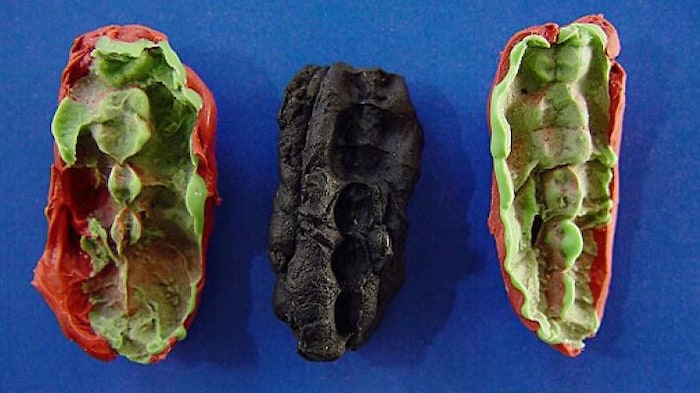Open in full screen mode Plasticine molding of one of the erasers. It captures the impressions of the teeth on each side. Agence France-Presse DNA found on gum chewed by Stone Age teenagers and found at a 9,700-year-old archaeological site in Sweden sheds light on oral diseases of the time, a Swedish study shows published in the journal Scientific reports (New window) (in English). The study a team of anthropologists from Stockholm University also provides information on the diet of these prehistoric hunter-gatherer populations. The chewing gum from which the samples were taken was probably chewed by adolescents, girls and boys. There was a specific age when they did this, explains Anders Götherström, co-author of the study in an interview with AFP. These pieces of birch bark soaked in saliva and bearing tooth marks were found 30 years ago alongside bones at the site of Huseby Klev, north of today's town of Gothenburg. It is one of the oldest archaeological sites with human bones in Scandinavia. It is believed that these erasers were used like glue, to assemble elements. It is also possible that they chewed them for pleasure or because they attributed medicinal virtues to them. A quote from Anders Götherström, Stockholm University Loading ELSE ON INFO: Prosecution of the Bettez family against the SQ: a closed session decided individually In 2019, an initial study of the pieces of putty made it possible to establish the genetic profile individuals. Now, traces of non-human DNA are being revealed. What we found was a large number of bacteria indicating a severe case of periodontitis, it's a serious infection of the gums, points out Anders Götherström. In one of the cases, we know that it was a young woman, she probably started to lose her teeth after chewing this chewing -gum. This infection must have hurt a lot, he adds. The research results also shed light on the diet of this Scandinavian community. A diversified diet of hazelnuts, deer and trout. Traces of apple, duck and fox DNA were also detected in the analyses. When we analyze a human bone, we extracted from human DNA. But what is particularly interesting with these chewing gums is to have the trace of what has been ingested before, and the bacteria of the person who wears them, there is no other way to obtain these results, enthuses Anders Götherström. We see the imprint made in a chewing gum by the teeth of adolescents thousands of years ago. For us archaeologists, there is also a philosophical dimension, it is the connection between man, DNA and the artifact, he concludes.
Prosecution of the Bettez family against the SQ: a closed session decided individually
Prehistoric chewing gum reveals its mysteries

